
Tumacácori National Historical Park is located in the upper Santa Cruz River Valley in Santa Cruz County, southern Arizona. The park consists of 360 acres (1.5 km2) in three separate units. The park protects the ruins of three Spanish mission communities, two of which are National Historic Landmark sites. It also contains the landmark 1937 Tumacácori Museum building, also a National Historic Landmark.
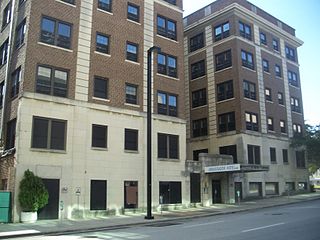
The 310 West Church Street Apartments, also known as the Ambassador Hotel, is a historic building located at 420 North Julia Street in Jacksonville, Florida, United States. On April 7, 1983, it was added to the U.S. National Register of Historic Places.
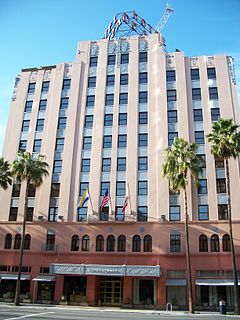
The Hotel De Anza is a historic hotel in San Jose, California. At ten stories, it once was the tallest hotel in the San Jose central business district, prior to the construction of Hilton, Fairmont, and Marriott hotels. Significant for its architectural style, it is one of San Jose's few Zig Zag Moderne buildings. The hotel was listed on the National Register of Historic Places on January 21, 1982.
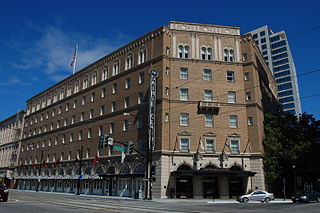
The Westin San Jose, housed in the historic Sainte Claire Hotel, is a six-story landmark hotel in Downtown San Jose. Built in 1926, it is listed on the National Register of Historic Places and one of the city's most recognized architectural landmarks.
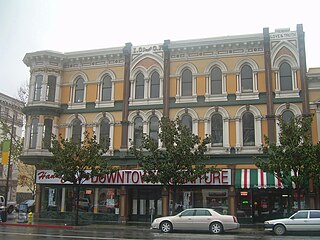
The Downtown Historic District of San Jose, California is a designated U.S. Historic District area of the city roughly the size of one square block. It is bounded by S. First Street to the west, E. San Fernando Street to the south, S. Third Street to the east, and E. Santa Clara Street to the north, but also includes the south side of E. Santa Clara Street between Third and Fourth Streets.

The Hayes Mansion is a historic mansion estate in the Edenvale neighborhood of San Jose, California. The mansion currently operates as a hotel resort and is currently known as The Hayes Mansion Hotel.

The Pasadena Civic Center District is the civic center of and a historic district in Pasadena, California. The district is roughly bounded by Walnut and Green Streets and Raymond and Euclid Avenues.

The Keating Building, also known as The Keating Hotel, is a 35-room luxury boutique hotel in San Diego. Located in the center of the Gaslamp Quarter, the Keating is located near the San Diego Convention Center, Balboa Theater, and Petco Park.

The San Agustin de Laredo Historic District is a historical district that covers what was once the original city of Laredo, Texas that was established by Don Tomás Sánchez. Today, the district is located in Downtown Laredo. The San Agustin District is home to San Agustin Cathedral and to the Republic of the Rio Grande Capitol. Most of the district's streets are made from bricks. Most of the buildings in the district reflect Spanish and Mexican influences and are made from masonry. The district is considered the last example of Spanish Colonization of the Lower Rio Grande Valley. The San Agustin de Laredo Historic District is registered in the National Register of Historic Places since 1973. Its historic significance is Architecture and Engineering. Its architectural style is Mission, Spanish Revival, and Greek Revival.
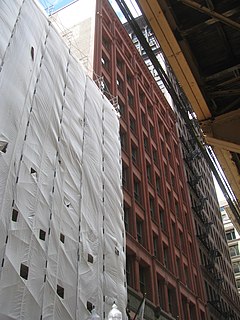
The Silversmith Hotel is a boutique hotel located in downtown Chicago, Illinois. It occupies the historic Silversmith Building, designed in 1896 by Peter J. Weber of the architectural firm of D.H. Burnham and Company, who also designed the Fisher Building. The building's architecture reflects the transition from Romanesque Revival architecture to Chicago school architecture. The Silversmith Building was listed on the National Register of Historic Places in 1997.
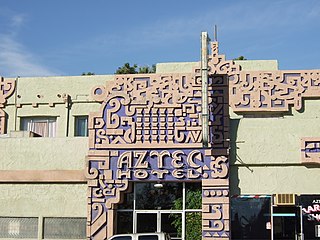
The Aztec Hotel is a historical landmark building in Monrovia, in the San Gabriel Valley, California. The hotel is an example of Mayan Revival architecture still in existence. It was designed by architect Robert Stacy-Judd, and built on U.S. Route 66 in 1925-26. The Aztec Hotel officially opened to public in September 1925, it contained over 40 rooms.

The Condado Vanderbilt Hotel is a historic luxury hotel built in 1919 and located on Ashford Avenue in the district of Condado, San Juan, in the U.S. territory of Puerto Rico. It was listed on the National Register of Historic Places in 2008. The hotel was designed by the architectural firm Warren and Wetmore, who also designed New York's Grand Central Terminal. It was built by the Vanderbilt family and it marked the beginning of high end tourism in Puerto Rico.
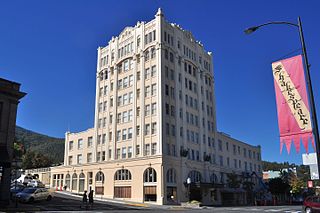
The Ashland Springs Hotel is a historic hotel in Ashland, Oregon, United States. Built in 1925, it was formerly known as the Mark Antony Motor Hotel or the Lithia Springs Hotel. It was listed on the National Register of Historic Places in 1978.
In the United States, the National Register of Historic Places classifies its listings by various types of architecture. Listed properties often are given one or more of 40 standard architectural style classifications that appear in the National Register Information System (NRIS) database. Other properties are given a custom architectural description with "vernacular" or other qualifiers, and others have no style classification. Many National Register-listed properties do not fit into the several categories listed here, or they fit into more specialized subcategories.

The Rogue Elk Hotel is a historic building in Trail, Oregon.

H.L. Stevens & Company was a Chicago-, New York-, and San Francisco-based architectural firm that designed hotels around the United States. At least 15 of its works are listed on the National Register of Historic Places for their architecture.
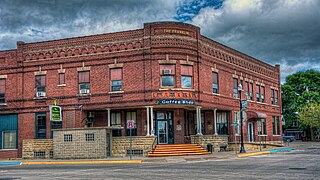
The Franklin Hotel is a historic building located in Strawberry Point, Iowa, United States. The Franklin Hotel and Land Company was established in 1902 for the purpose of building a modern hotel to serve the community. They hired the Independence, Iowa architectural firm of Netcott and Donnan to design the building, which was constructed by E.M. Loop of Hopkinton, Iowa. The hotel opened on February 12, 1903, and the building has served that purpose ever since. The two-story brick building combines the Neoclassical and Romanesque Revival styles. It sits on the northeast corner of an intersection and its rounded corner follows the curve of the intersection. The commercial space adjacent to the north is also a part of this building with hotel rooms on the second floor. Railroad tracks at one time were located just north of the hotel, which served the passengers from the railroad and later travelers from the highways that run past the hotel. The building was listed on the National Register of Historic Places in 1999.

The Midwest Oil Company Hotel, at 136 East 6th Street in Casper, Wyoming, is an historic hotel building which was listed on the National Register of Historic Places in 1983. It has also served as the Casper Women's Club House. Originally built by the Midwest Oil Company to accommodate workers during the Casper oil boom, it was taken over by Standard Oil Company of Indiana when that company bought Midwest Oil. In the 1930s, in the waning days of oil production in Natrona County, a local women's organization bought the hotel for $8,000 and was renamed the Casper Women's Club House.

The Twohy Building is a historic building in San Jose, California, located on the Paseo de San Antonio in Downtown San Jose. It was built in 1917 for Judge John W. Twohy, the founder of the Twohy Brothers Construction Company. The company focused on "design and heavy/civil construction of railroads, bridges, tunnels, and public wprks projects, as well as manufacturing railroad cars, World War I "Victory" ships, and ownership of railroads. In 1906, the Twohy family relocated to San Jose to construct the nearby Bayshore Cut-Off for Southern Pacific and supervise repairs to railroad bridges damaged by the San Francisco earthquake" For example, it built part of the Southern Pacific Railway.

Abraham Horace Albertson was an American architect who was one of Seattle, Washington's most prominent architects of the first half of the 20th century. He was born in New Jersey and educated at Columbia University in New York. Early in his career, he moved to Seattle in the employ of a well-known New York architectural firm with that was developing a large area in downtown. He worked on many projects in Seattle from around 1910 through the 20s and early 30s. Some of his designs are Seattle landmarks and/or listed on the National Register of Historic Places.




















